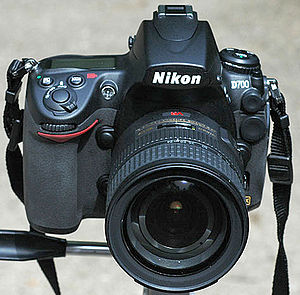 | |
| Overview | |
|---|---|
| Type | Single-lens reflex |
| Released | 1 July 2008 |
| Lens | |
| Lens | Interchangeable, Nikon F mount |
| Sensor/medium | |
| Sensor | 36 mm × 23.9 mm CMOS, 8.45 µm pixel size |
| Sensor maker | Nikon[1] |
| Maximum resolution | 4,256 × 2,832 (12.1 million) |
| Film speed | 200–6400, extended mode to 100–12800, HI2 mode 25600 |
| Storage media | CompactFlash (Type I only) |
| Focusing | |
| Focus modes | Single-servo (AF-S); Continuous-servo (AF-C); Manual (M) |
| Focus areas | 51 AF points (15 cross-type) |
| Exposure/metering | |
| Exposure metering | TTL 3D Color Matrix Metering II with a 1005-pixel RGB sensor |
| Metering modes | Matrix metering, center-weighted metering, spot metering |
| Flash | |
| Flash | Manual pop-up with button release Guide number 12/39 (ISO 100, m/ft) |
| Flash bracketing | -3 to +1 EV in increments of 1/3 or 1/2 EV |
| Shutter | |
| Shutter | Electronically controlled focal-plane |
| Shutter speed range | 1/8000 to 30 sec, bulb, X-sync at 1/250 sec. |
| Continuous shooting | Approx. 5.0 frame/s, 8.0 frame/s w/battery grip |
| Viewfinder | |
| Viewfinder | Optical pentaprism, 95% coverage |
| General | |
| LCD screen | 3.0-inch (76 mm), VGA resolution, 307,200 pixels (921,600 dots) |
| Battery | Nikon EN-EL3e rechargeable Lithium-Ion battery |
| Dimensions | 147×123×77 mm (5.8×4.8×3.0 in) |
| Weight | 995 g (35.1 oz), body only |
| Made in | |
| Chronology | |
| Successor | Nikon D800 |
The Nikon D700 is a professional-grade full-frame digital single-lens reflex camera introduced by the Nikon Corporation in July 2008 and manufactured in Japan.[2] It uses the same 12.1-megapixel "FX" CMOS image sensor as the Nikon D3, and is Nikon's second full-frame digital SLR camera.
The D700's full-frame sensor allows the use of F-mount (FX) lenses to their fullest advantage, with almost no crop factor. When a cropped DX lens is mounted on the D700, either the DX-sized portion, or the (vignetted) FX-sized portion of the camera's sensor can be used. The D700 has a built in autofocus motor for all Nikon autofocus-lenses, includes CPU and metering for older Nikon F-mount AI/AI-S lenses,[3] and supports PC-E lenses.[4] The D700 bears a physical similarity to the Nikon D300, which uses the same MB-D10 battery pack and EN-EL3e battery. It was discontinued on August 24, 2012.[5]